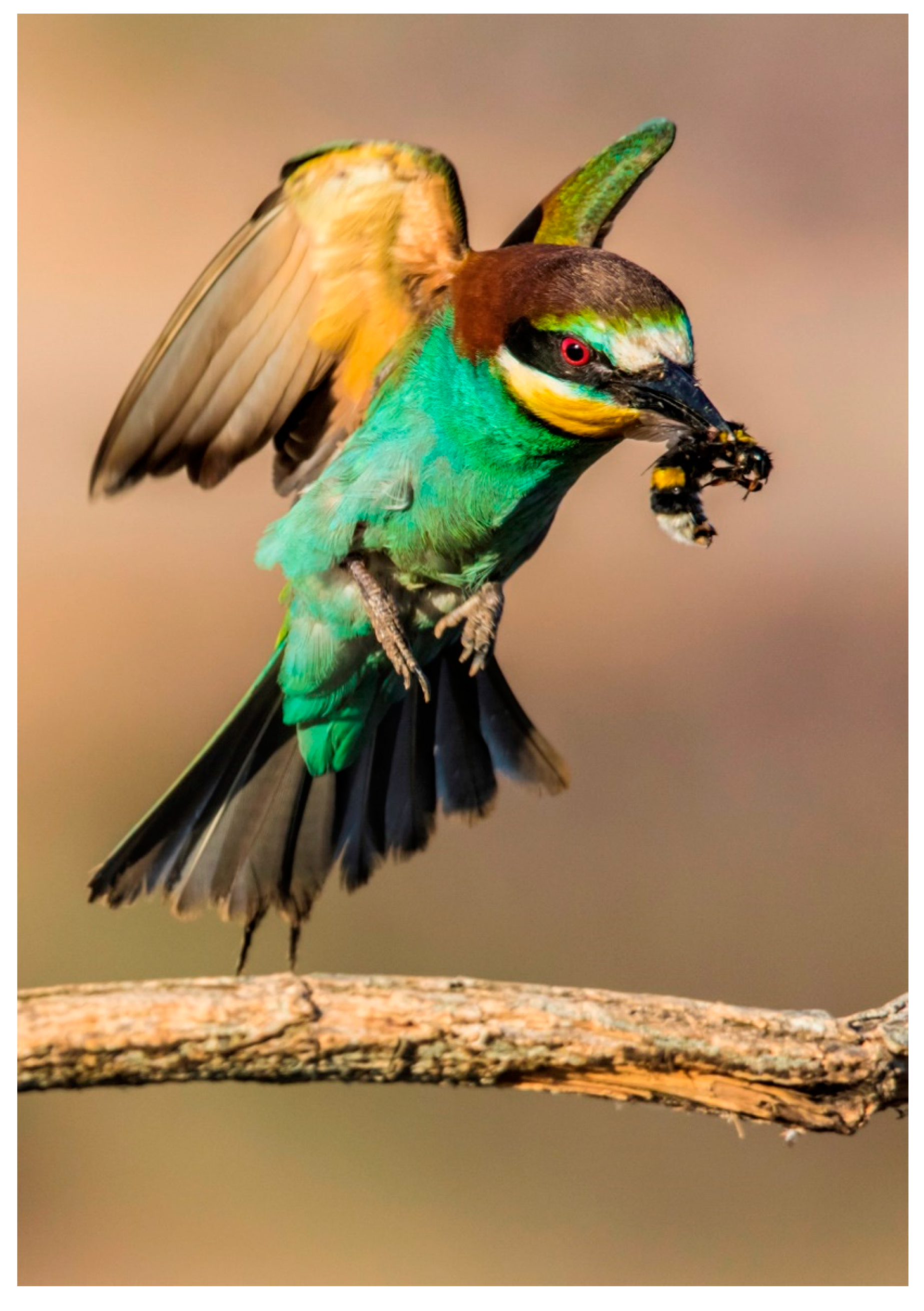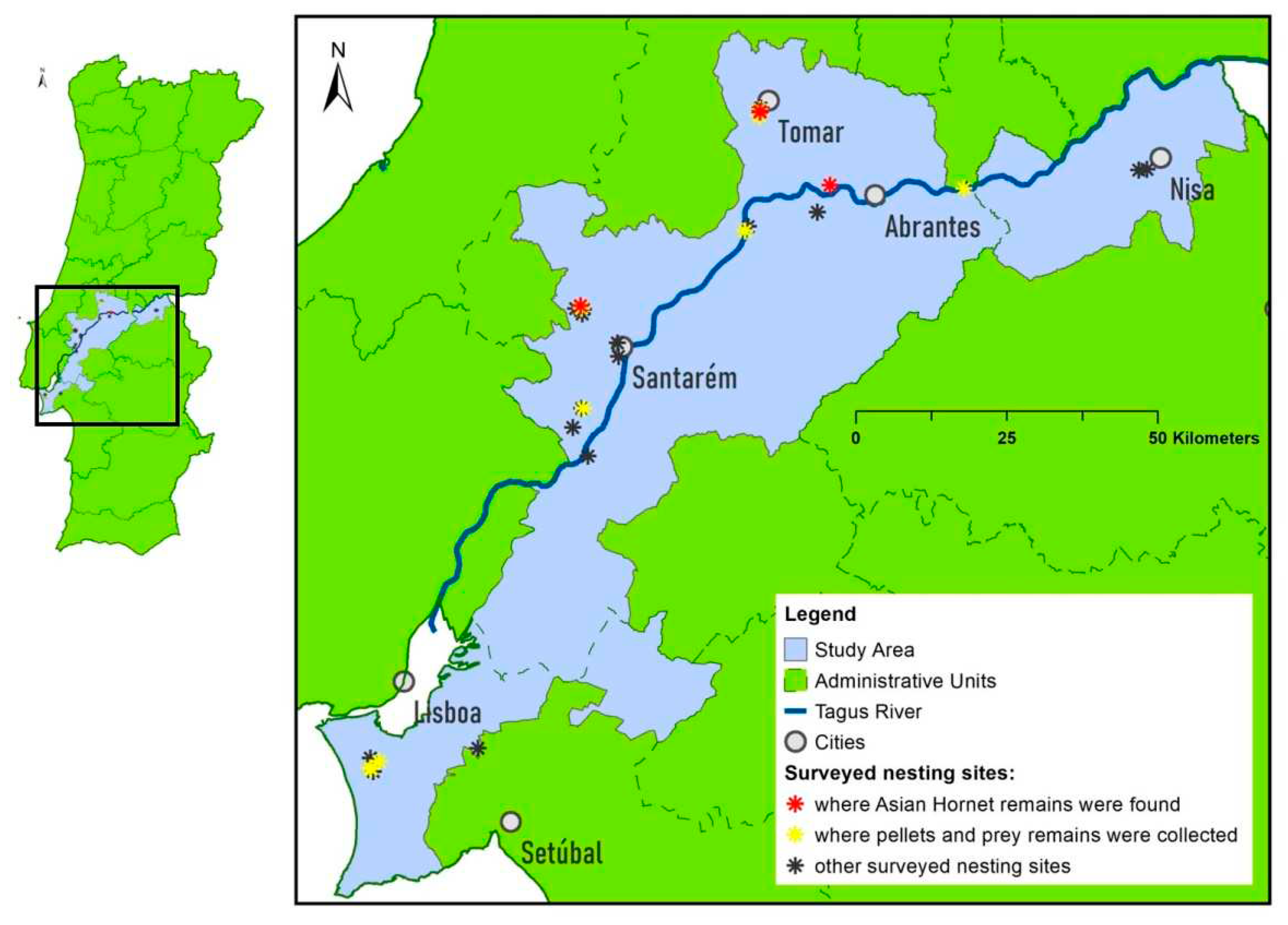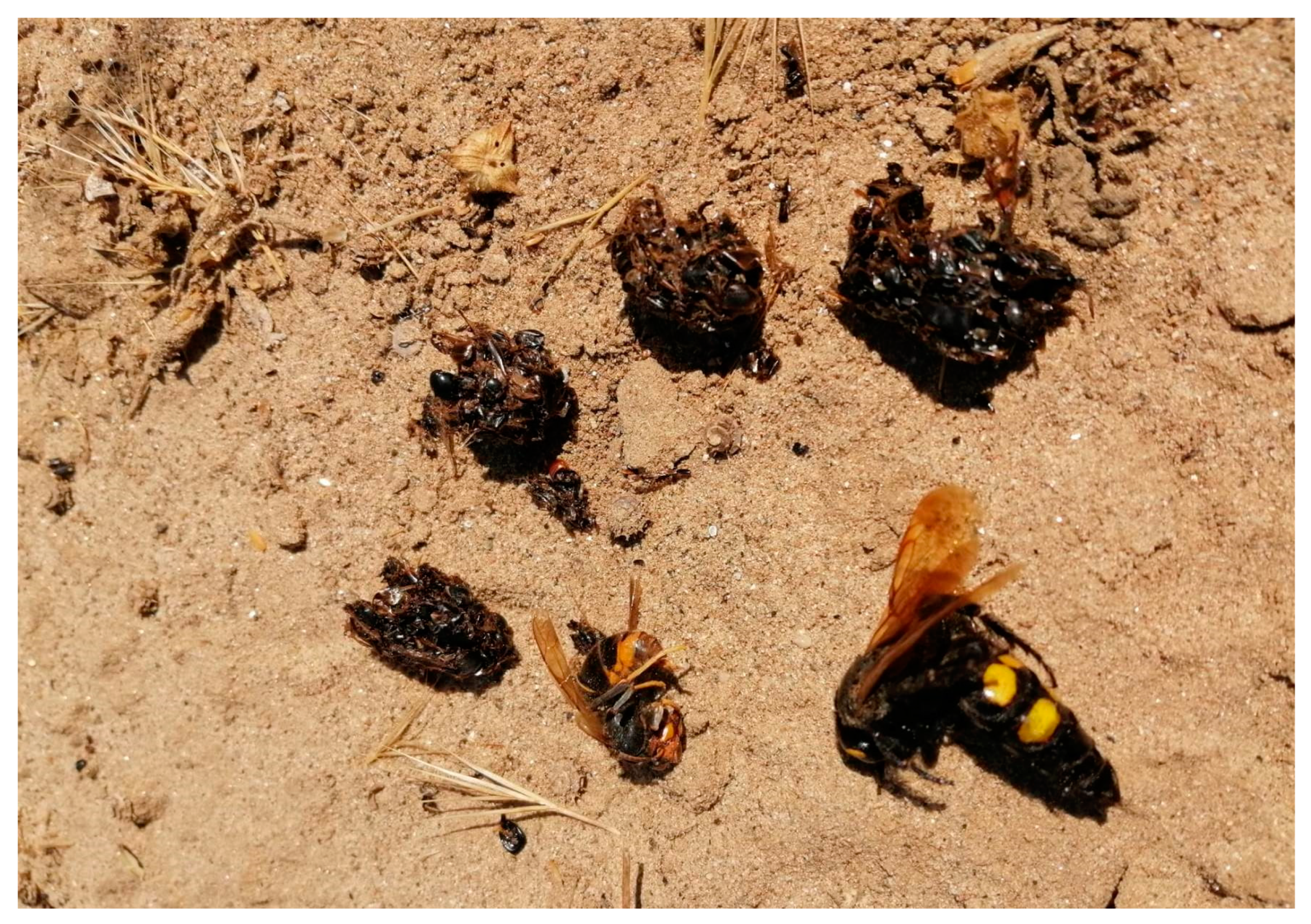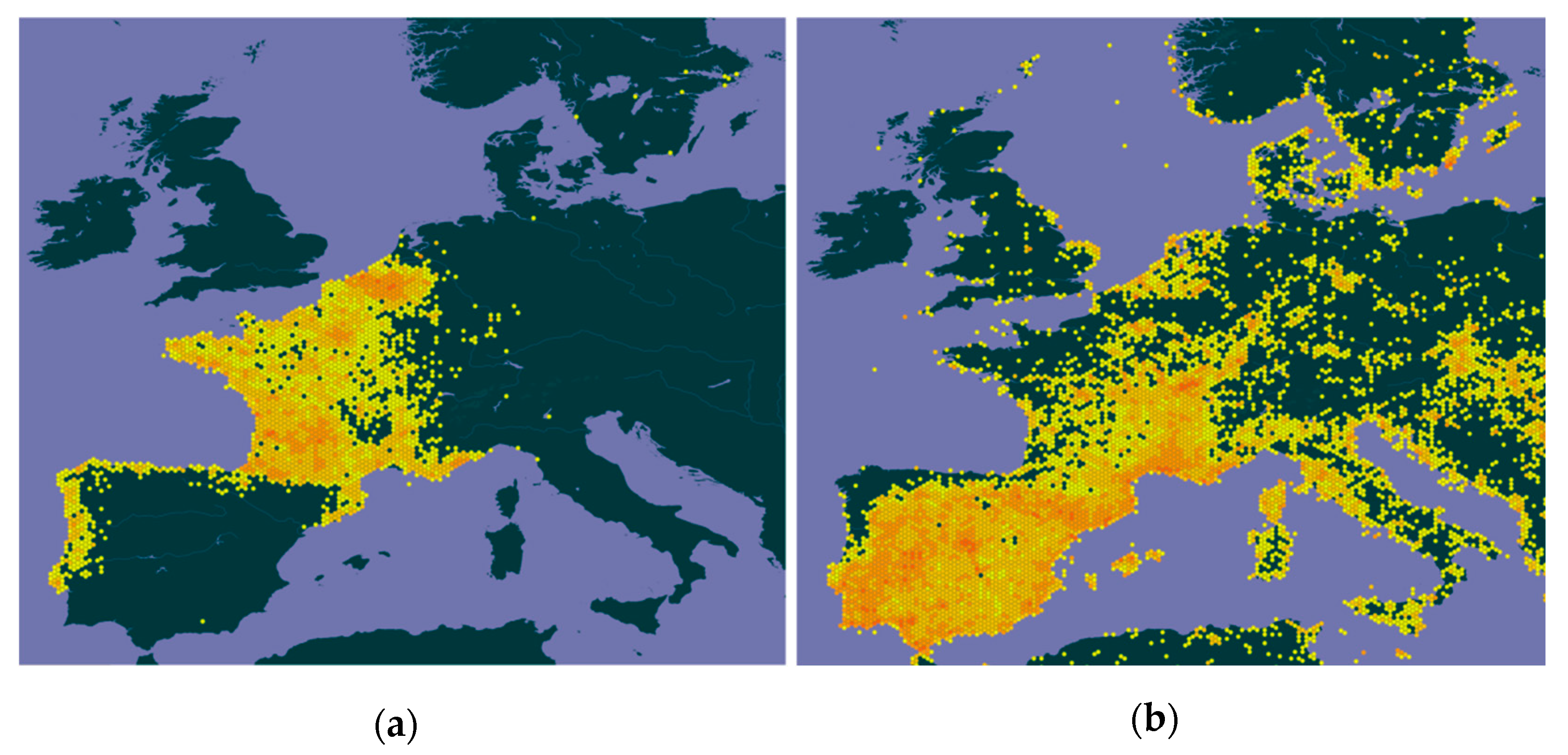Submitted:
17 April 2023
Posted:
18 April 2023
You are already at the latest version
Abstract
Keywords:
1. Introduction
2. Materials and Methods
3. Results
4. Discussion
5. Conclusions
Author Contributions
Funding
Institutional Review Board Statement
Informed Consent Statement
Data Availability Statement
Acknowledgments
Conflicts of Interest
References
- UN (2022). Standard country or area codes for statistical use (M49). Statistics Division, Department of Economic and Social Affairs, United Nations: New York. Available online: https://unstats.un.org/unsd/methodology/m49/.
- Perrard, A.; Arca, M.; Rome, Q.; Muller, F.; Tan, J.; Bista, S.; Nugroho, H.; Baudoin, R.; Baylac, M.; Silvain, J.-F.; Carpenter, J.M.; Villemant, C. Geographic variation of melanisation patterns in a hornet species: Genetic differences, climatic pressures or aposematic constraints? PLoS ONE 2014, 9, e94162. [Google Scholar] [CrossRef] [PubMed]
- Laurino, D.; Lioy, S.; Carisio, L.; Manino, A.; Porporato, M. Vespa velutina: An alien driver of honey bee colony losses. Diversity 2020, 12, 5. [Google Scholar] [CrossRef]
- Barbet-Massin, M.; Salles, J.; Courchamp, F. The economic cost of control of the invasive yellow-legged Asian hornet. NeoBiota 2020, 55, 11–25. [Google Scholar] [CrossRef]
- Bunker, S. Vespa velutina (Asian hornet). CABI Compendium. Available online: https://www.cabidigitallibrary.org/doi/10.1079/cabicompendium.109164 (accessed on 28 February 2023).
- Rojas-Nossa, S.V.; Gil, N.; Mato, S.; Garrido, J. Vespa velutina: características e impactos de una exitosa especie exótica invasora. Ecosistemas 2021, 30, 2159. [Google Scholar] [CrossRef]
- Monceau, K.; Bonnard, O.; Thiéry, D. Vespa velutina: A new invasive predator of honeybees in Europe. J. Pest Sci. 2014, 87, 1–16. [Google Scholar] [CrossRef]
- Nave, A.; Fernandes, J.; Ferreira, M.A.; Rato, F.; Godinho, J. A vespa-asiática, Vespa velutina, espécie exótica e invasora em Portugal. Vida Rural 2022, 263, 58–64. [Google Scholar]
- Rodríguez-Flores, M.S. , Seijo-Rodríguez, A.; Escuredo, O.; Seijo-Coello, M. del C. Spreading of Vespa velutina in northwestern Spain: influence of elevation and meteorological factors and effect of bait trapping on target and non-target living organisms. J. Pest Sci. 2019, 92, 557–565. [Google Scholar] [CrossRef]
- Villemant, C.; Barbet-Massin, M.; Perrard, A.; Muller, F.; Gargominy, O.; Jiguet, F.; Rome, Q. Predicting the invasion risk by the alien bee-hawking Yellow legged hornet Vespa velutina nigrithorax across Europe and other continents with niche models. Biol. Conserv. 2011, 144, 2142–2150. [Google Scholar] [CrossRef]
- Verdasca, M.J.; Godinho, R.; Rocha, R.G.; Portocarrero, M.; Carvalheiro, L.G.; Rebelo, R.; Rebelo, H. A metabarcoding tool to detect predation of the honeybee Apis mellifera and other wild insects by the invasive Vespa velutina. J. Pest Sci. 2022, 95, 997–1007. [Google Scholar] [CrossRef]
- Rojas-Nossa, S.V.; Calviño-Cancela, M. The invasive hornet Vespa velutina affects pollination of a wild plant through changes in abundance and behaviour of floral visitors. Biol. Invasions 2020, 22, 2609–2618. [Google Scholar] [CrossRef]
- Villemant C.; Muller, F.; Rome, Q.; Thiery, D. Evolution des populations du Frelon Asiatique (Vespa velutina, Lepeletier 1836) en France: Conséquences écologiques et socio-économiques. Proposition de mise en œuvre d’un plan d’action. Convention MEEDM/MNHN 2009 - fiche 3. Rapport 2009/7. Muséum National d'Histoire Naturelle: Paris, France, Octobre 2009, 14 p. Available online: http://spn.mnhn.fr/spn_rapports/archivage_rapports/2009/SPN%202009%20-%207%20-%20Vespa%20velutina.pdf.
- Cerri, J.; Lioy, S.; Porporato, M.; Bertolino, S. Combining surveys and on-line searching volumes to analyze public awareness about invasive alien species: a case study with the invasive Asian yellow-legged hornet (Vespa velutina) in Italy. NeoBiota 2022, 73, 177–192. [Google Scholar] [CrossRef]
- Rome, Q.; Villemant, C. Le Frelon asiatique Vespa velutina - Inventaire national du Patrimoine naturel. Muséum national d’Histoire naturelle [Ed]: Paris, France. Available online: http://frelonasiatique.mnhn.fr (accessed on 28 February 2023).
- Ibáñez-Justicia, A.; Loomans, A.J.M. Mapping the potential occurrence of an invasive species by using CLIMEX: case of the Asian hornet (Vespa velutina nigrithorax) in The Netherlands. Proc Neth Entomol Soc Meet. 2011, 22, 39–46. Available online: https://www.researchgate.net/publication/260277540_Mapping_the_potential_occurrence_of_an_invasive_species_by_using_CLIMEX_case_of_the_Asian_hornet_Vespa_velutina_nigrithorax_in_The_Netherlands_Proc_Neth_Entomol_Soc_Meet/citation/download.
- Barbet-Massin, M.; Rome, Q.; Muller, F.; Perrard, A.; Villemant, C.; Jiguet, F. Climate change increases the risk of invasion by the yellow-legged hornet. Biol. Conserv. 2013, 157, 4–10. [Google Scholar] [CrossRef]
- Monceau, K.; Maher, N.; Bonnard, O.; Thiéry, D. Predation pressure dynamics study of the recently introduced honeybee killer Vespa velutina: learning from the enemy. Apidologie 2013, 44, 209–221. [Google Scholar] [CrossRef]
- Verdasca, M.J.; Carvalheiro, L.; Aguirre Gutierrez, J.; Granadeiro, J.P.; Rome, Q.; Puechmaille, S.J.; Rebelo, R.; Rebelo, H. Contrasting patterns from two invasion fronts suggest a niche shift of an invasive predator of native bees. PeerJ. 2022, 10, e13269. [Google Scholar] [CrossRef] [PubMed]
- Robinet, C.; Darrouzet, E.; Suppo, C. Spread modelling: a suitable tool to explore the role of human-mediated dispersal in the range expansion of the yellow-legged hornet in Europe. Int. J. Pest Manag. 2019, 65, 258–267. [Google Scholar] [CrossRef]
- Balmori, A. Sobre el riesgo real de una expansión generalizada de la avispa asiática Vespa velutina Lepeletier, 1836 (Hymenoptera: Vespidae) en la Península Ibérica. Boletín de la S.E.A. 2015, 56, 283–289. [Google Scholar]
- Matsuura, M.; Yamane, S. Biology of Vespine Wasps, 1st ed.; Springer-Verlag: Berlin Heidelberg, Germany, 1990; 323p. [Google Scholar] [CrossRef]
- Kim, C.-J.; Choi, M.B. First Discovery of Vespa velutina nigrithorax du Buysson (Hymenoptera: Vespidae), an Invasive Hornet in the Feces of the Yellow-Throated Marten in South Korea. Insects 2021, 12, 296. [Google Scholar] [CrossRef] [PubMed]
- Spradbery, P.J. Wasps: An Account of the Biology and Natural History of Solitary and Social Wasps., 1st ed.; University of Washington Press: Seatle, USA, 1973; 408p. [Google Scholar]
- Edwards, R. Social Wasps. Their Biology and Control; 1st ed.; Rentokil Ltd.: East Grinstead, UK, 1980; 398p. [Google Scholar]
- Fox-Wilson, G. Factors affecting populations of social wasps, Vespula species, in England (Hymenoptera). Proc. R. Entomol. Soc. Lond. Ser. A Gen. Entomol. 1946, 21, 17–27. [Google Scholar] [CrossRef]
- van Bergen, V.S. The Honey-Buzzards of the Sensebezirk: First Findings on Density, Diet, Reproduction and Food Competition in a Swiss Population of Honey-Buzzard Pernis Apivorus. 2019, December 12. 12 December. [CrossRef]
- Nadolski, J. Factors restricting the abundance of wasp colonies of the European hornet Vespa crabro and the Saxon wasp Dolichovespula saxonica (Hymenoptera: Vespidae) in an urban area in Poland. Entomol. Fenn. 2013, 24, 204–215. [Google Scholar] [CrossRef]
- Pusceddu, M.; Lezzeri, M.; Cocco, A.; Floris, I.; Satta, A. Bio-Ethology of Vespa crabro in Sardinia (Italy), an Area of New Introduction. Biology 2022, 11, 518. [Google Scholar] [CrossRef]
- Mollet, T.; de la Torre, C. Vespa velutina. The Asian Hornet. Bull. Tech. Agric. 2006, 33, 203–208. [Google Scholar]
- Villemant, C.; Muller, F.; Haubois, S.; Perrard, A.; Darrouzet, E.; Rome, Q. Bilan des Travaux (MNHN et IRBI) sur l’invasion en France de Vespa velutina, le frelon asiatique prédateur d’abeilles. In Journée Scientifique Apicole; Barbançon J.-M., L’Hostis, M. Eds.; JSA, Arles, ONIRIS-FNOSAD: Nantes, France, 11 Février 2011, pp 3-12. Available online: http://inpn.mnhn.fr/fichesEspece/Vespa_velutina_fichiers/2011_02_11_Bilan_Invasion_Vespa_velutina_JSA.pdf.
- Bessa, A.S.; Carvalho, J.; Gomes, A.; Santarém, F. Climate and land-use drivers of invasion: predicting the expansion of Vespa velutina nigrithorax into the Iberian Peninsula. Insect Conserv. Divers. 2016, 9, 27–37. [Google Scholar] [CrossRef]
- Fournier, A.; Barbet-Massin, M.; Rome, Q.; Courchamp, F. Predicting species distribution combining multi-scale drivers. Glob. Ecol. Conserv. 2017, 12, 215–226. [Google Scholar] [CrossRef]
- Carvalho, J.; Hipólito, D.; Santarém, F.; Martins, R.; Gomes, A.; Carmo, P.; Rodrigues, R.; Grosso-Silva, J.; Fonseca, C. Patterns of Vespa velutina invasion in Portugal using crowdsourced data. Insect Conserv. Divers 2020, 13, 501–507. [Google Scholar] [CrossRef]
- Krebs, J.R.; Avery, M.I. Central place foraging in the European Bee-eater, Merops apiaster. J. Anim. Ecol. 1985, 54, 459–472. [Google Scholar] [CrossRef]
- Krištín, A. Breeding biology and diet of the bee-eater (Merops apiaster) in Slovakia. Biologia (Bratisl.) 1994, 49, 273–279. [Google Scholar]
- Kiss, J.B.; Rekasi, J. Date privind hrana în Delta Dunării a unor specii de păsări granivore şi insectivore strict protejate. Analele Ştiinţifice ale Institutului Delta Dunării 1995, 4, 123–129. [Google Scholar]
- Galeotti, P.; Inglisa, M. Estimating predation impact of Honeybees Apis mellifera L. by European Bee-eaters Merops apiaster. Rev. Ecol. (Terre Vie) 2001, 56, 373–388. [Google Scholar] [CrossRef]
- Krištín, A.; Kaňuch, P. Šíri sa včelárik zlatý (Merops apiaster) severným smerom? K výskytu a potrave v Podpoľaní a okolí Zvolena (stredné Slovensko). Tichodroma 2005, 17, 89–94. [Google Scholar]
- Lourenço, P.M. Internet photography forums as sources of avian dietary data: bird diets in Continental Portugal. Airo 2018, 25, 3–26. [Google Scholar]
- Gamauf, A. Der Wespenbussard (Pernis apivorus) ein Nahrungsspezialist? Der Einfluß sozialer Hymenopteren auf Habitatnutzung und Home Range-Größe. Egretta 1999, 12, 57–85. [Google Scholar]
- Roberts, S.J.; Lewis, J.M.S.; Williams, I.T. Breeding European Honey-buzzards in Britain. Br. Birds 1999, 92, 326–345. [Google Scholar]
- Lepley, M.; Thevenot, M.; Guillaume, C.-P.; Ponei, P.; Bayle, P. Diet of the nominate Southern Grey Shrike Lanius meridionalis meridionalis in the north of its range (Mediterranean France). Bird Study 2004, 51, 156–162. [Google Scholar] [CrossRef]
- Tryjanowski, P.; Karg, M.K.; Karg, J. Diet composition and prey choice by red-backed shrike Lanius collurio in western Poland. Belg. J. Zool. 2003, 133, 157–162. [Google Scholar]
- Owen, D.F. The Food of Nestling Jays and Magpies. Bird Study 1956, 4, 257–265. [Google Scholar] [CrossRef]
- Labouyrie, F. Winter larders of the Iberian Grey Shrike Lanius meridionalis in southern France. Alauda 2020, 88, 35–44. [Google Scholar]
- Vigneaud, J.P. Gironde: fait rarissime, un rapace dévore un nid de frelons asiatiques. Sud Ouest, 2013, 20 August. Available online: https://www.sudouest.fr/environnement/frelon-asiatique/gironde-fait-rarissime-un-rapace-devore-un-nid-de-frelons-asiatiques-8644366.php.
- Macià, F.X.; Menchetti. M.; Corbella, C.; Grajera, J.; Vila, R. Exploitation of the invasive Asian Hornet Vespa velutina by the European Honey Buzzard Pernis apivorus. Bird Study 2019, 66, 425–429. [Google Scholar] [CrossRef]
- Rebollo, S.; Rey-Benayas, J.M.; Villar-Salvador, P.; Pérez-Camacho, L.; Castro, J.; Molina-Morales, M.; Leverkus, A.B.; Baz, A.; Martínez-Baroja, L.; Quiles, P.; et al. Servicios de la avifauna (high-mobile link species) en mosaicos agroforestales: regeneración forestal y regulación de plagas. Ecosistemas 2019, 28, 32–41. [Google Scholar] [CrossRef]
- Sequeira, I. Novo documentário mostra a vida selvagem a conviver com os humanos em Lousada. Wilder. 2020, 19 Mars. Available online: https://www.wilder.pt/?s=Novo+document%C3%A1rio+mostra+a+vida+selvagem+a+conviver+com+os+humanos+em+Lousada.
- Onofre, N.; Portugal e Castro, M.I.; Nave, A.; Godinho, J. Os Predadores Naturais da Vespa-Asiática (Vespa velutina) e a Contribuição do Abelharuco (Merops apiaster) para o seu Controlo. Silva Lusit. 2022, 30, 1–16. [Google Scholar] [CrossRef]
- Villemant, C.; Rome, Q.; Haxaire, J. Le Frelon asiatique (Vespa velutina) – In Muséum National d'Histoire Naturelle [Ed]. Inventaire national du Patrimoine Naturelle [Ed]: Paris, France, 2010. Available online: https://inpn.mnhn.fr/fichesEspece/Vespa_velutina_en.html (accessed on 28 February 2023).
- Palomino, D.; Valls, J. Las rapaces forestales en España. Población reproductora en 2009-2010 y método de censo; SEO/BirdLife: Madrid, España, 2011; 153 p.
- Anonymous. El abejero liquidó 24.500 nidos de velutina en Galicia. Faro de Vigo. 2019, 31 Mars. Available online: https://www.farodevigo.es/sociedad/2019/03/31/abejero-liquido-24-500-nidos-15733121.html.
- Purroy, J.; Purroy, F.J. Abejero europeo –Pernis apivorus. In Enciclopedia Virtual de los Vertebrados Españoles; Salvador, A., Morales, M.B., Eds.; Museo Nacional de Ciencias Naturales: Madrid, España, 2016. Available online: http://www.vertebradosibericos.org/. (accessed on 28 February 2023).
- Valera, F. Abejaruco europeo – Merops apiaster. In Enciclopedia Virtual de los Vertebrados Españoles; Salvador, A., Morales, M.B., Eds.; Museo Nacional de Ciencias Naturales: Madrid, España, 2016; Available online: http://www.vertebradosibericos.org/ (accessed on 28 February 2023).
- Orta, J.; Kirwan, G.M.; Garcia, E.F.J. European Honey-buzzard (Pernis apivorus), version 1.0. In Birds of the World; del Hoyo, J., Elliott, A., Sargatal, J., Christie, D.A., de Juana, E., Eds.; Cornell Lab of Ornithology: Ithaca, NY, USA, 2020. Available online: https://birdsoftheworld.org/bow/species/euhbuz1/cur/introduction (accessed on 28 February 2023).
- Bastian, H.-V.; Bastian, A. European Bee-eater (Merops apiaster), version 2.0. Birds of the World. In Birds of the World; Billerman, S.M., Keeney, B.K., Eds.; Cornell Lab of Ornithology, Ithaca, NY, USA, 2022. Available online: https://birdsoftheworld.org/bow/species/eubeat1/cur/introduction (accessed on 28 February 2023).
- Birkhead, TR. Predation by birds on social wasps. Br. Birds 1974, 67, 221–229. [Google Scholar]
- Massa, B.; Rizzo, M.C. Nesting and feeding habits of the European Bee-eater (Merops apiaster L.) in a colony next to a beekeeping site. Avocetta 2002, 26, 25–31. [Google Scholar]
- Herrera, C.M.; Ramírez, A. Food of Bee-eaters in Southern Spain. Br. Birds 1974, 67, 158–164. [Google Scholar]
- Martínez, C. Notes sur l'alimentation du Guêpier (Merops apiaster L.) dans une colonie du centre de l'Espagne. Alauda 1984, 52, 45–50. [Google Scholar]
- GIC. La evaluacion del impacto de la ecologia del Abejaruco (Merops apiaster) sobre el sector apicola en el ambito rural Transfronteriza de Extremadura. Grupo de Investigacion en Biologia de la Conservacion (G.I.C.), Universidad de Extremadura, Junta Extremadura. Informe definitivo, 2007, December; 27 pp. Available online: http://extremambiente.juntaex.es/files/interreg/faunatrans/estudios_mejoras/impacto%20ecologia%20abejaruco%20definitivo.pdf.
- Costa, J.; Rocha, A.; Alves, J.A. Diet of adult and nestling Bee-eaters (Merops apiaster) in Portugal. In IX Congresso de Ornitologia da SPEA, Vila Real, Portugal, 23 – 25 April 2016. Available online: https://www.researchgate.net/publication/313882699_Diet_of_adult_and_nestling_Bee-eaters_Merops_apiaster_in_Portugal.
- GBIF Secretariat Vespa velutina subsp. nigrithorax Buysson, 1905. GBIF Backbone Taxonomy. Available online: https://www.gbif.org/species/6247411 (accessed on 28 February 2023).
- GBIF Secretariat. Pernis apivorus (Linnaeus, 1758). GBIF Backbone Taxonomy. Available online: https://www.gbif.org/species/2480420 (accessed on 28 February 2023).
- Keller, V.; Herrando, S.; Voříšek, P.; Franch, M.; Kipson, M.; Milanesi, P.; Martí, D.; Anton, M.; Klvaňová, A.; Kalyakin, M.V.; et al. European Breeding Bird Atlas 2: Distribution, Abundance and Change; European Bird Census Council & Lynx Edicions: Barcelona, Spain. https://ebba2.info/maps/species/Merops-apiaster/ebba2/breeding/ (accessed on 28 February 2023).
- GBIF Secretariat. Merops apiaster Linnaeus, 1758. GBIF Backbone Taxonomy. Available online: https://www.gbif.org/species/2475443 (accessed on 28 February 2023).
- STOPVespa. Mapa STOPvespa. Available online: https://stopvespa.icnf.pt/geovisualizador/ (accessed on 28 February 2023).
- Equipa Atlas. Atlas das Aves Nidificantes em Portugal (1999-2005); Instituto da Conservação da Natureza e da Biodiversidade, Sociedade Portuguesa para o Estudo das Aves, Parque Natural da Madeira e Secretaria Regional do Ambiente e do Mar, Assírio & Alvim: Lisboa, Portugal, 2008; 590 p.
- Chinery, M. Insects of Britain and Western Europe., 2nd ed.; A & C Black Publishers Ltd: London, UK, 2007. [Google Scholar]
- DGAV. Plano de Ação para o controlo de Rhynchophorus ferrugineus (Olivier). Direcção Geral da Alimentação e Veterinária. Ministério da Agricultura e do Mar: Lisboa, Portugal, 2013, October; 19 p. Available online: https://www.drapc.gov.pt/base/documentos/plano_accao_r%20_ferrugineus%20_2013_dgav.pdf. /.
- Verdasca, M.J.; Rebelo, H.; Carvalheiro, L.G.; Rebelo, R. Invasive hornets on the road: motorway-driven dispersal must be considered in management plans of Vespa velutina. NeoBiota 2021, 69, 177–198. [Google Scholar] [CrossRef]
- MAGRAMA. Estrategia de gestión, control y posible erradicación del Avispón asiático o Avispa negra (Vespa velutina ssp. nigrithorax) en España. Estratégias de control - Critérios orientadores. Espécies Exóticas Invasoras, Ministério de Agricultura, Alimentación y Medio Ambiente, Govierno de España: Madrid, España, 2015; 58 p. Available online: https://www.miteco.gob.es/es/biodiversidad/publicaciones/estrategia_vespavelutina_tcm30-69976.pdf.
- Kim, S.-H.; Kim, D.; Lee, H.; Jung, S.; Hee, W.-H. Ensemble evaluation of the potential risk areas of yellow-legged hornet distribution. Environmental Monitoring and Assessment 2021, 193, 601. [Google Scholar] [CrossRef] [PubMed]
- Voous, K.H. Atlas of European birds, 1st ed.; Thomas Nelson and Sons: New York, USA, 1960; 284p. [Google Scholar]
- Kinzelbach, R.; Nicolai, B.; Schlenker, R. Der Bienenfresser Merops apiaster als Klimazeiger: Zum Einflug in Bayern, der Schweiz und Baden im Jahr 1644. J. fur Ornithol. 1997, 138, 297–308. [Google Scholar] [CrossRef]
- Bastian, A.; Bastian, H.-V.; Fiedler, W.; Rupp, J.; Todte, I.; Weiss, J. Der Bienenfresser (Merops apiaster) in Deutschland – eine Erfolgsgeschichte. Fauna Flora Rheinl.-Pfalz 2013, 12, 861–894. [Google Scholar]
- Bastian, H.-V. Go North – Bienenfresser vom Mittelmeer bis zur Ostsee? Jahrb. Natschutz. Hessen 2014, 15, 138–141. [Google Scholar]
- Fiedler W. Chapter 17. Bird ecology. In Climate change – Observed impacts on earth, 3rd ed.; Letcher, T.M. Ed.; Elsevier: Amsterdam, Boston, Heidelberg, London, New York, Oxford, Paris, San Diego, San Francisco, Singapore, Sydney, Tokyo, 2021; pp. 373–388. Climate change – Observed impacts on earth. [CrossRef]
- Stiels, D.; Bastian, H.V.; Bastian, A.; Schidelko, K.; Engler, J.O. An iconic messenger of climate change? Predicting the range dynamics of the European Bee-eater (Merops apiaster). J. Ornithol. 2021, 162, 631–644. [Google Scholar] [CrossRef]
- Lioy, S.; Bergamino, C.; Porporato, M. The invasive hornet Vespa velutina: distribution, impacts and management options. CABI Reviews. 2022, 19 October. [CrossRef]
- Aymí, R. (2003). Abejaruco europeo Merops apiaster. In Atlas de las aves reproductoras de España; Martí, R., del Moral, J. C. Eds.; Dirección General de Conservación de la Naturaleza-Sociedad Española de Ornitología: Madrid, España; pp. 344–345.
- Carrascal, L. M.; Palomino, D. Las aves comunes reproductoras en España. Población en 2004-2006. SEO/BirdLife, Madrid, 2008; 202 p.
- Catry, P., Costa, H., Elias, G., Matias, R., Aves de Portugal - Ornitologia do Território Continental. Assírio & Alvim: Lisboa, Portugal, 2010; 944 p.
- Gordo, O.; Aymí, R.; Molina, B. Der Bienenfresser Merops apiaster in Spanien: seine Verbreitung, Häufigkeit und Bedrohung. Vogelwarte 2021, 59, 235–245. [Google Scholar]
- Aymí, R.; Gordo, O. Abejaruco europeo Merops apiaster. In III Atlas de las aves en época de reproducción en España, Molina, B., Nebreda, A., Muñoz, A.R., Seoane, J., Real, R., Bustamante, J., del Moral, J.C. Eds.; SEO/BirdLife: Madrid, España, 2022. Available online: https://atlasaves.seo.org/ave/abejaruco-europeo/ (accessed on 28 February 2023).
- Araújo, M.B.; Guilhaumon, F.; Neto, D.R.; Pozo, I.; Calmaestra, R. (2011). Impactos, Vulnerabilidad y Adaptación al Cambio Climático de la Biodiversidad Española. 2 Fauna de Vertebrados, 1st ed.; Dirección general de medio Natural y Política Forestal. Ministerio de Medio Ambiente, y Medio Rural y Marino: Madrid, España, 2011; 640p. [Google Scholar]
- MNHN & OFB (Ed) Fiche de Vespa velutina Lepeletier, 1836. Inventaire national du patrimoine naturel (INPN): France, 2003-2023. Available online: https://inpn.mnhn.fr/espece/cd_nom/433589 (accessed on 28 February 2023).
- Dellwisch, B; Bastian, A; Bastian, H.-V.; Schidelko, K.; Stiels, D.; Engler, J.O. Bienenfresser Merops apiaster in Deutschland – woher sie kamen, wohin sie gehen. Vogelwarte 2021, 59, 197–206.
- LPO. Guêpier d'Europe Merops apiaster. Le projet ODF, Répartitions, Tendances et Effectifs. Oiseaux de France. Ligue pour la Protection des Oiseaux (LPO). Available online: https://oiseauxdefrance.org/prospecting?species=3582 (accessed on 28 February 2023).
- Loury, P.; Puissauve, R. Fiches d’information sur les espèces aquatiques protégées: Guêpier d’Europe, Merops apiaster Linnaeus, 1758. Service du patrimoine naturel du MNHN & Onema, 2016; 4 p. Available online: https://inpn.mnhn.fr/fichesEspece/EspecesEauDouce/Guepier_europe-M.apiaster_2016.pdf (accessed on 28 February 2023).
- Bastian, H.-V. (2022). 10. Jahresbericht der FG “Bienenfresser” der DO-G. Fachgruppe “Bienenfresser” der Deutschen Ornithologen-Gesellschaft; 7 p. http://www.do-g.de/fileadmin/Jahresbericht_2022_-_Zehnter_Bericht_der_FG_Bienenfresser_DO-G.pdf. Available online: https://atlasaves.seo.org/ave/abejaruco-europeo/. /.
- Monceau, K.; Bonnard, O.; Thiéry, D. Chasing the queens of the alien predator of honeybees: A water drop in the invasiveness ocean. Open J. Ecol. 2012, 2, 183–191. [Google Scholar] [CrossRef]
- Rome, Q; Muller, F.; Touret-Alby, A.; Darrouzet, E.; Perrard, A.; Villemant, C. Caste differentiation and seasonal changes in Vespa velutina (Hym.: Vespidae) colonies in its introduced range. J. Appl. Entomol. 2015, 139, 771–782. [CrossRef]




| Order | Family | Subfamily | Genus or Species |
|---|---|---|---|
| HEMIPTERA | Cicadellidae | ||
| DIPTERA | Syrphidae | Eristalinae | Volucella zonaria |
| HYMENOPTERA | Apidae | Apinae | Apis mellifera |
| Bombus sp. | |||
| Melecta sp. | |||
| Xylocopinae | Xylocopa violacea | ||
| Crabronidae | |||
| Scoliidae | Scoliinae | Megascolia maculata | |
| Vespidae | Polistinae | Polistes gallicus | |
| Polistes sp. | |||
| Vespinae | Vespa crabro | ||
| Vespa velutina | |||
| Vespula germanica | |||
| Vespula sp. | |||
| COLEOPTERA | Staphylinidae | ||
| Geotrupidae | |||
| Scarabaeidae | Cetoniinae | Cetonia sp. | |
| Protaetia sp. | |||
| Buprestidae | Buprestinae | Buprestis sp. | |
| Tenebrionidae | Tenebrioninae | Blaps sp. | |
| Curculionidae | Rhynchophorinae | Rhynchophorus ferrugineus |
Disclaimer/Publisher’s Note: The statements, opinions and data contained in all publications are solely those of the individual author(s) and contributor(s) and not of MDPI and/or the editor(s). MDPI and/or the editor(s) disclaim responsibility for any injury to people or property resulting from any ideas, methods, instructions or products referred to in the content. |
© 2023 by the authors. Licensee MDPI, Basel, Switzerland. This article is an open access article distributed under the terms and conditions of the Creative Commons Attribution (CC BY) license (http://creativecommons.org/licenses/by/4.0/).





